SharePoint의 계산된 열 | 개요

SharePoint에서 계산된 열의 중요성과 목록에서 자동 계산 및 데이터 수집을 수행하는 방법을 알아보세요.
Python 에서 부동 소수점 숫자를 자르는 것은 많은 프로그래머가 다양한 응용 프로그램에서 접하는 일반적인 작업입니다. 이 프로세스에는 float의 소수 자릿수를 제거하고 정수 부분만 남깁니다. 이는 계산을 단순화하고 출력의 가독성을 개선하며 잠재적인 반올림 오류를 줄이는 데 유용한 기술입니다.
Python에서 float 값을 자르려면 math.trunc() 함수, decimal 모듈 또는 문자열 조작을 사용할 수 있습니다. 이러한 기술을 사용하여 Python 개발자는 절단 프로세스를 유연하고 정확하게 특정 요구 사항에 맞게 조정할 수 있습니다.

이 기사에서는 Python 프로그래밍 내에서 잘림을 적용하여 보다 효율적이고 능률적인 코드를 만드는 방법을 살펴보겠습니다 . 우리는 최대의 효과를 위해 이 기술을 사용하는 방법에 대한 종합적인 관점을 제시하면서 다양한 실제 사례를 탐구할 것입니다.
Python에서 문자열, 숫자 및 데이터 구조를 자르는 기본 개념과 기술을 살펴보는 것으로 시작하겠습니다.
목차
Python 잘라내기 기본 사항
이 섹션에서는 잘림의 정의를 다루고 잘림에 대한 Python 함수를 살펴보고 소수 자릿수와 부동 소수점을 자르는 방법을 배웁니다.
1. Python에서 Truncate의 정의
자르기는 소수점 이하 자릿수를 제거하여 숫자를 줄이는 과정입니다. 컴퓨터 과학 및 수학에서 중요한 개념이며 값을 변경하지 않고 숫자를 더 간단한 형식으로 줄이는 데 사용됩니다.
2. Python Truncate 함수 사용 방법
Python에서 절대값을 자르는 방법에는 여러 가지가 있습니다. 잘라내기를 수행하는 한 가지 일반적인 방법 은 이진 부동 소수점 값에서 소수점 이하 자릿수를 직접 제거하는 math.trunc() 함수를 사용하는 것입니다 .
예를 들면 다음과 같습니다.
import math
float1 = 123.356
float2 = -2434.545
print(math.trunc(float1))
print(math.trunc(float2))
산출:
123
-2434이 메서드는 소수점 이하 자릿수를 제거하여 주어진 숫자를 자르는 int() 함수 와 유사한 결과를 제공합니다 .
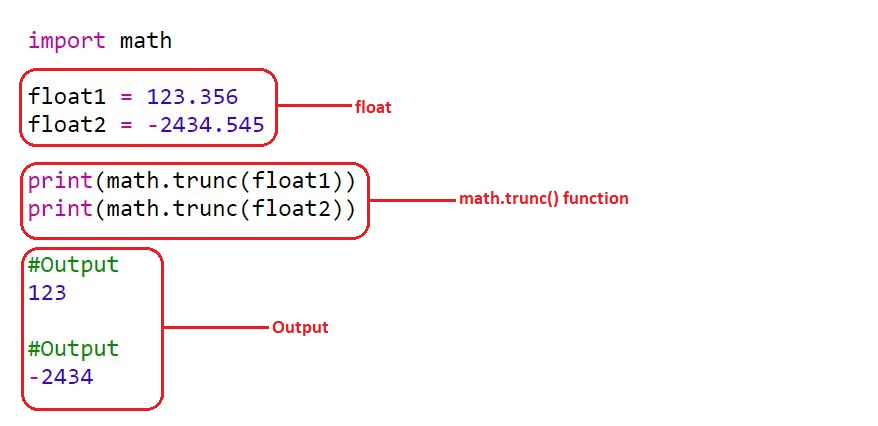
3. 파이썬에서 소수 자릿수와 실수를 자르는 방법
경우에 따라 부동 소수점을 특정 십진수로 잘라야 할 수도 있습니다. 이러한 경우 round() 함수를 사용하여 숫자를 반올림할 수 있습니다 . 그러나 round() 함수는 숫자를 자르지 않고 반올림만 한다는 점에 유의하십시오.
특정 소수점으로 자르려면 다음 방법을 사용할 수 있습니다.
def truncate_float(float_number, decimal_places):
multiplier = 10 ** decimal_places
return int(float_number * multiplier) / multiplier
float3 = 3.14159
result = truncate_float(float3, 2)
print(result)
산출:
3.14
위의 예에서 truncate_float() 함수는 자를 float 수와 원하는 소수점 수의 두 가지 매개 변수를 사용합니다.
승수를 사용하여 먼저 float의 소수점을 이동한 다음 결과를 정수로 변환하고(효과적으로 숫자를 자름) 마지막으로 정수를 승수로 나누어 소수점을 원래 위치로 복원합니다.
Python에서 float로 작업하면 부동 소수점 산술의 특성으로 인해 계산이 약간 부정확해질 수 있음을 명심하십시오. 따라서 정확도와 정밀도가 중요한 경우 십진수 모듈 사용을 고려하십시오.
자, 이것이 Python에서 값을 자르는 방법의 기본 사항입니다. 다음 섹션에서는 수학 라이브러리 및 기타 Python 함수를 사용하여 값을 자르는 방법을 살펴보겠습니다.
수학 라이브러리 및 함수를 사용하여 Python에서 자르기
Python 프로그래밍 영역에서 최적화는 종종 핵심입니다. Python의 '수학' 라이브러리와 내장 함수를 사용하면 특히 대규모 데이터 세트나 복잡한 계산을 처리할 때 성능을 크게 향상시킬 수 있습니다.
이 섹션은 Python에서 데이터 크기를 효율적으로 줄이거나 제한하는 잘라내기 작업을 위해 'math' 라이브러리와 강력한 기능을 활용하는 방법을 탐구하는 데 전념합니다.
1. math.trunc()
Python 수학 라이브러리는 부동 소수점 값으로 작동하는 여러 함수를 제공하며 그 중 하나는 math.trunc() 입니다 . 이 함수는 주어진 float의 잘린 값을 반환하여 소수 부분을 효과적으로 제거하고 정수 부분만 남깁니다.
다음은 math.trunc() 사용 방법의 예입니다 .
import math
number = 3.7
truncated_number = math.trunc(number)
print("Original number:", number)
print("Truncated number:", truncated_number)
산출:
3
3.7math.trunc()는 숫자를 0으로 반올림합니다. 양수의 경우 floor 함수처럼 작동하고 음수의 경우 ceiling 함수처럼 작동합니다.
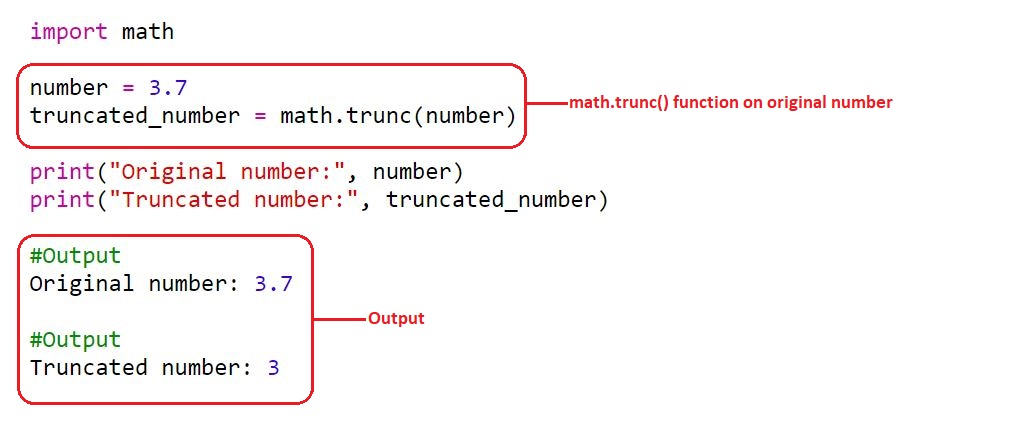
2. math.floor() 및 math.ceil()
math.trunc() 외에도 수학 라이브러리는 math.floor () 및 math.ceil() 함수와 같이 다양한 방식으로 숫자를 반올림하는 함수도 제공합니다.
math.floor () 함수는 부동 소수점 값을 가장 가까운 정수로 내림하고 math.ceil()은 가장 가까운 정수로 내림합니다.
import math
# Example using math.floor() function
x = 3.7
y = 9.2
floor_x = math.floor(x)
floor_y = math.floor(y)
print("Floor of x:", floor_x)
print("Floor of y:", floor_y) 산출:
Floor of x: 3
Floor of y: 9다음은 math.floor() 함수 의 예시입니다.
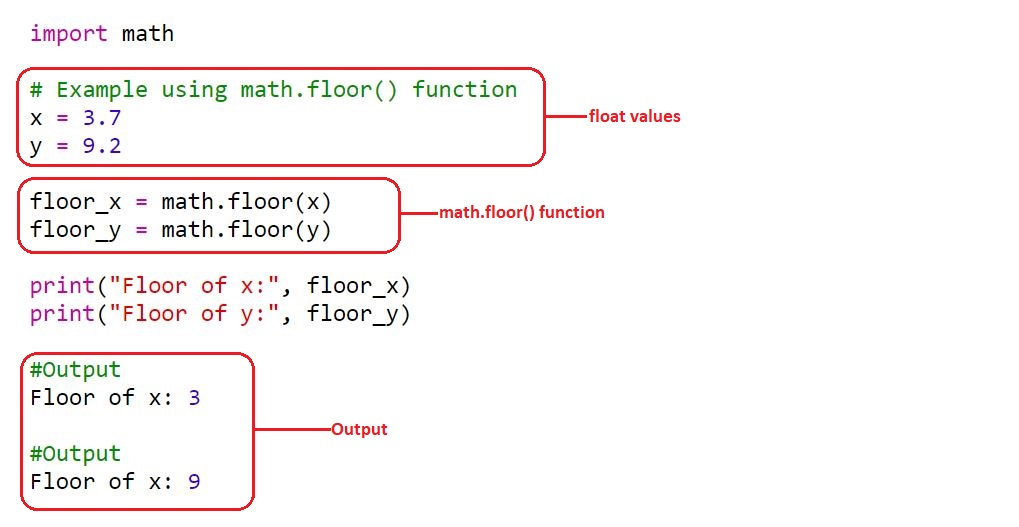
이 코드 스니펫은 math.ceil() 함수 의 사용법을 보여줍니다 .
import math
# Example usage of math.ceil()
x = 3.7
y = 9.2
z = -4.5
ceil_x = math.ceil(x)
ceil_y = math.ceil(y)
ceil_z = math.ceil(z)
# Output the results
print("Ceiling of", x, "is", ceil_x)
print("Ceiling of", y, "is", ceil_y)
print("Ceiling of", z, "is", ceil_z)
산출:
Ceiling of 3.7 is 4
Ceiling of 9.2 is 10
Ceiling of -4.5 is -4
3. int()를 사용한 부동 값 변환
float 값을 자르는 또 다른 방법은 내장 int() 함수를 사용하는 것입니다. float에 전달되면 소수 부분을 잘라서 정수로 변환합니다.
이 접근 방식은 수학 라이브러리를 가져올 필요가 없기 때문에 간단한 자르기 사례에 더 편리할 수 있습니다.
float5 = 7.65
float6 = -3.14
print(int(float5))
print(int(float6))
산출:
7
-3그러나 int() 함수는 부호를 고려하지 않고 숫자만 자르기 때문에 math.floor() 또는 math.ceil() 과 동일하지 않다는 점을 기억하는 것이 중요합니다.
다음은 코드 편집기에서 float 자르기에 대한 위의 int() 함수 의 그림입니다 .
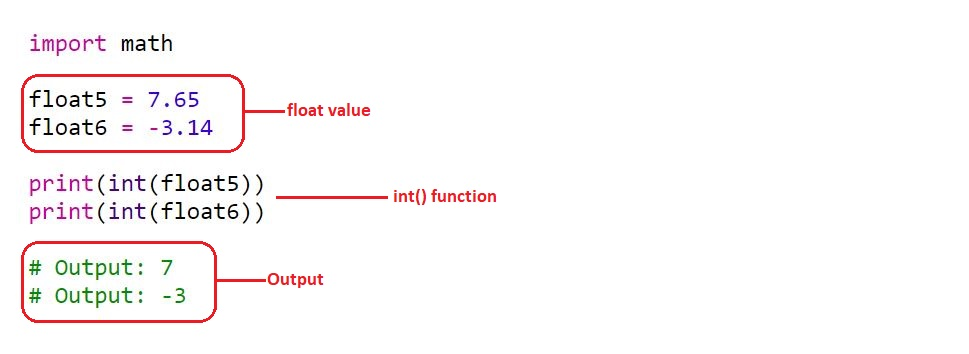
요약하면 Python 수학 라이브러리는 자르기, 내림 및 반올림을 포함하여 부동 소수점 값을 사용하는 여러 함수를 제공합니다. 수학 라이브러리는 고급 수학 연산을 수행해야 할 때 의존하는 필수 도구입니다.
int() 및 math.trunc() 함수는 부동 소수점 값을 자르는 간단한 방법을 제공하지만 decimal 모듈 은 더 강력하고 정확한 접근 방식을 제공하므로 다음 섹션에서 살펴보겠습니다.
Decimal 모듈을 사용하여 Python에서 값을 자르는 방법
Python의 'decimal' 모듈은 잘림이 필요할 때 특히 유용한 기능인 십진수를 정밀하게 처리하는 강력한 도구입니다.
이 섹션에서는 Python에서 값을 자르기 위한 이 모듈의 실제 응용 프로그램에 대해 자세히 설명합니다. 단계별 예제를 살펴보고 이 효과적이고 정확한 데이터 조작 기술의 이면에 있는 개념에 대한 심층적인 이해를 제공합니다.
1. 퀀타이즈 방법 사용하기
Decimal 클래스 의 양자화 방법은 십진수 인스턴스 를 자르기 위한 다목적 도구입니다. 이 방법을 사용하면 개발자가 원하는 정밀도와 반올림 모드를 설정하여 정확한 절단을 보장할 수 있습니다.
다음 예를 고려하십시오.
from decimal import Decimal, ROUND_DOWN
number = Decimal('3.14159')
truncated = number.quantize(Decimal('1.'), rounding=ROUND_DOWN) print(truncated)산출:
3In this example, the quantize method is applied to the Decimal instance number with a precision of one decimal place and the ROUND_DOWN rounding mode, which effectively truncates the value.
2. Using the to_integral_value Method
Another useful method provided by the Decimal class is to_integral_value. This method returns the nearest integer to the given decimal value, effectively truncating the decimal places.
The to_integral_value method allows developers to specify the rounding mode as well.
Here’s an example:
from decimal import Decimal, ROUND_DOWN
number = Decimal('3.14159')
truncated = number.to_integral_value(rounding=ROUND_DOWN) print(truncated)Output:
3In this example, the to_integral_value method is used with the ROUND_DOWN rounding mode, resulting in truncation.
3. Applying the Normalize Method
The normalize method of the Decimal class provides a way to adjust the exponent and scale of a decimal instance. By using this method, developers can effectively truncate the decimal places.
Consider the following example:
from decimal import Decimal
number = Decimal('3.14159')
truncated = number.normalize()
print(truncated)Output:
3.14159In this example, the normalize method is applied to the Decimal instance number, resulting in the same value without any decimal places.
Next, let’s look at ways you can truncate strings and lists in Python.
Truncation Techniques for Strings and Lists in Python
In this section, we’ll discuss various techniques for truncating strings and lists in Python functions. We’ll cover the following sub-sections: string truncate techniques and list truncation.
1. String Truncate Techniques
There are multiple ways to truncate a string in Python, including the use of str.format, slicing, and f-strings.
1) Using str.format: This method allows you to truncate a string by specifying a precision value. For example:
truncated_string = '{:.5}'.format('aaabbbccc')
print(truncated_string)
Output:
aaabb2) Using slicing: By using slice notation, you can select a substring of the original string. For example:
my_string = 'aaabbbccc'
truncated_string = my_string[:5]
print(truncated_string)
Output:
aaabb3) Using f-strings: With f-strings, the truncation can be performed inline within the string. For example:
my_string = 'aaabbbccc'
truncated_string = f'{my_string[:5]}'
print(truncated_string)
Output:
aaabb2. List Truncation
There are several ways to truncate lists in Python, such as slicing and using list comprehensions.
1) Using slicing: Slicing allows you to select a range of elements in a list. For example:
my_list = [1, 2, 3, 4, 5, 6, 7, 8, 9]
truncated_list = my_list[:5]
print(truncated_list)
Output:
[1, 2, 3, 4, 5]2) Using list comprehensions: List comprehensions allow you to create a new list by iterating over an existing list and applying a condition or operation. For example, to truncate tuples in a list:
my_list = [('apple', 3), ('orange', 5), ('banana', 2)]
truncated_list = [(fruit, count) for fruit, count in my_list if count < 5]
print(truncated_list)
Output:
[('apple', 3), ('banana', 2)]
Now that we’ve covered the various techniques for truncating strings and lists using Python, let’s take a look at how you can do the same using libraries like NumPy and pandas.
How to Use NumPy and pandas to Truncate Values in Python
When it comes to numerical and data analysis in Python, the names ‘NumPy’ and ‘pandas’ undoubtedly resonate among developers. These powerful libraries have transformed the landscape of data manipulation by providing extensive functionality for array processing, data handling, and much more.
In this section, we’ll explore common ways to truncate elements in Python using NumPy and pandas DataFrames.
1. Truncation in Python Using NumPy
NumPy offers a simple, built-in function called trunc which allows you to truncate values to the nearest whole number.
The trunc function eliminates the fractional part of the input, returning only the integer.
import numpy as np
values = np.array([1.234, 5.678, 9.012])
truncated_values = np.trunc(values)
print(truncated_values)
Output:
array([1., 5., 9.])
Here are some key points about the trunc function:
It works element-wise, meaning it can truncate each element in an array or a list.
The data type (dtype) of the output array will be the same as the input array.
The function can be applied to different data structures, such as lists, tuples, or arrays, as long as the elements are numeric.
2. Using DataFrame and Loc for Truncation in Python
Pandas DataFrame is a powerful, flexible data structure for handling large, structured datasets. You can use the DataFrame.truncate() function to truncate a DataFrame based on the index.
To see a practical demonstration of how to load datasets in Python, watch this YouTube video:
Alternatively, you can use the loc property to filter rows or columns based on a specific condition.
import pandas as pd
data = {'A': [1.234, 5.678, 9.012], 'B': [4.567, 8.901, 2.345]}
df = pd.DataFrame(data)
# Truncating based on the index
truncated_df = df.truncate(before=1, after=2)
print(truncated_df)
Output:
A B
1 5.678 8.901
2 9.012 2.345
Using loc and a condition, we can achieve truncation based on values as well:
# Condition to truncate values in column 'A'
condition = (df['A'] < 6)
# Truncating DataFrame based on condition
truncated_df = df.loc[condition]
print(truncated_df)
Output:
A B
0 1.234 4.567
1 5.678 8.901
In this example, a boolean condition was used to filter out rows in the DataFrame. Depending on your use case, you can apply different conditions and operations using loc.
Let’s now look at the practical applications of truncation in Python.
3 Practical Applications of Truncation in Python
Understanding the concept of truncation in Python and its corresponding techniques is only half of the equation. The other half involves applying this knowledge effectively in practical scenarios.
In this section, we transition from theory to practice, illustrating how truncation can be used to optimize Python code in real-world applications.
Truncation is useful in various applications, some of which are:
1. 재무 계산 : 통화로 작업할 때 센트만 고려되고 더 작은 단위는 관련이 없는 실제 돈을 나타내기 위해 소수점 값을 자르는 것이 일반적입니다.
price = 49.987
truncated_price = int(price * 100) / 100
print(truncated_price)
산출:
49.98
2. 데이터 집계 : 자르기는 특정 기준에 따라 데이터를 집계하는 데에도 사용할 수 있습니다. 예를 들어, 정수 값을 기준으로 일일 온도 판독값의 평균값을 집계합니다.
temperature_data = [22.3, 23.9, 24.8, 23.4, 22.7, 24.1, 24.6]
truncated_temperature = [int(temp) for temp in temperature_data]
mean_temperature = sum(truncated_temperature) / len(truncated_temperature)
print(mean_temperature)
산출:
23.142857142857142
3. 요소 정렬 : 때때로 특정 절단 규칙에 따라 요소를 정렬해야 합니다. 이것은 Python의 sorted() 함수 에서 key 매개변수를 사용하여 달성할 수 있습니다 .
data = [4.8, 3.2, 2.9, 7.5, 6.1, 9.0, 1.5]
sorted_data = sorted(data, key=lambda x: int(x))
print(sorted_data)
산출:
[1.5, 2.9, 3.2, 4.8, 6.1, 7.5, 9.0]
절단의 이러한 실제 응용 프로그램은 데이터 분석 및 기계 학습과 같은 다양한 분야에서 매우 중요함을 보여줍니다.
그러나 중요한 질문이 생깁니다. 잘라내기 기술은 어떻게 비교되며 주어진 시나리오에 대해 어떤 방법을 사용해야 합니까? 이에 답하기 위해 다음 섹션에서는 논의한 다양한 절단 방법에 대한 비교 분석에 대해 자세히 설명합니다.
Python의 절단 방법 비교
성능 및 정밀도 측면에서 다양한 잘라내기 방법을 비교하기 위해 대규모 데이터 세트를 고려하고 각 접근 방식의 실행 시간을 측정해 보겠습니다.
import random
import time
from decimal import Decimal, ROUND_DOWN
import math
# Generate a large dataset of floating-point values
data = [random.uniform(0, 1000) for _ in range(10**6)]
# Using int function
start_time = time.time()
truncated_int = [int(number) for number in data]
int_execution_time = time.time() - start_time
# Using math.trunc function
start_time = time.time()
truncated_math = [math.trunc(number) for number in data]
math_execution_time = time.time() - start_time
# Using decimal module
start_time = time.time()
truncated_decimal = [Decimal(str(number)).quantize(Decimal('1.'), rounding=ROUND_DOWN) for number in data]
decimal_execution_time = time.time() - start_time
print(f"Execution time using int function: {int_execution_time:.5f} seconds")
print(f"Execution time using math.trunc function: {math_execution_time:.5f} seconds")
print(f"Execution time using decimal module: {decimal_execution_time:.5f} seconds")
이 예에서는 0에서 1000 사이의 백만 개의 임의 부동 소수점 값 데이터 세트가 생성됩니다. 각 절단 방법에 대한 실행 시간은 time 모듈을 사용하여 측정됩니다. Decimal 모듈 접근 방식은 정확한 결과를 보장하기 위해 자르기 전에 각 숫자를 Decimal 인스턴스로 변환합니다.
코드를 실행하면 각 메서드의 실행 시간을 관찰하고 성능을 비교할 수 있습니다.
적절한 절단 방법 선택
Python에서 부동 소수점 값을 자르는 경우 적절한 방법을 선택하는 것은 응용 프로그램 또는 사용 사례의 특정 요구 사항에 따라 다릅니다.
사용할 방법을 결정할 때 다음 요소를 고려하십시오.
정밀도: 정밀도가 가장 중요하고 소수 자릿수를 미세하게 제어해야 하는 경우 decimal 모듈이 최고 수준의 정확도를 제공합니다.
성능: 높은 정밀도가 필요하지 않은 간단한 자르기의 경우 int() 함수와 math.trunc() 함수가 효율적인 솔루션을 제공합니다.
반올림 동작: 원하는 반올림 동작에 따라 decimal 모듈을 사용하여 ROUND_DOWN , ROUND_UP , ROUND_HALF_UP 등과 같은 다양한 반올림 모드를 지정할 수 있습니다.
호환성: Decimal 모듈을 지원하지 않는 레거시 코드 또는 시스템과의 호환성을 보장해야 하는 경우 int() 함수 또는 math.trunc 함수가 실행 가능한 옵션이 될 수 있습니다.
마지막 생각들
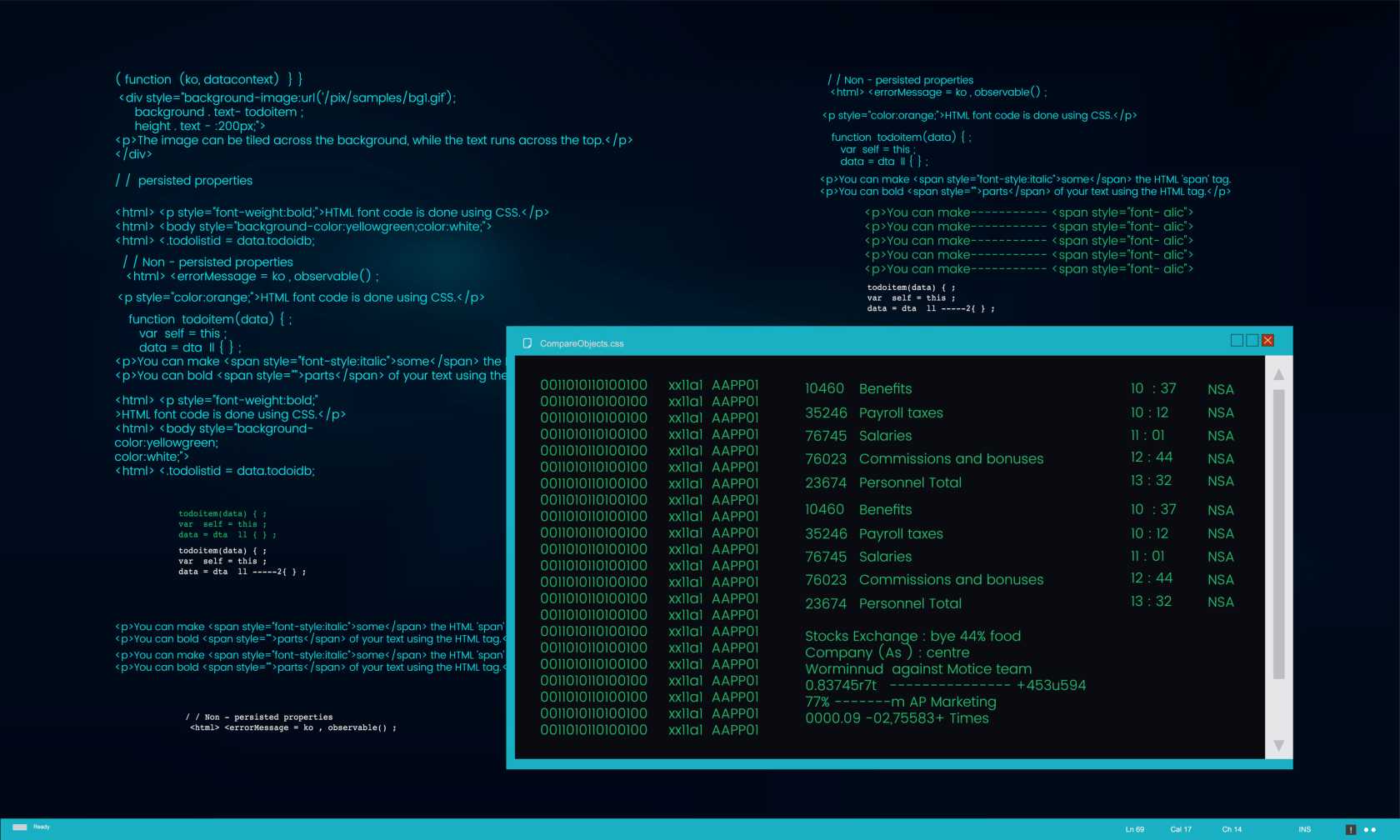
정확한 데이터 조작 및 분석을 위해서는 Python에서 float 값을 자르는 기본 사항을 이해하는 것이 필수적입니다. Python은 특정 요구 사항에 따라 부동 소수점 숫자를 자르거나 반올림하는 다양한 메서드와 함수를 제공합니다.
math.trunc() , math.floor() 및 math.ceil() 과 같은 내장 함수를 사용하여 자르기 작업을 효과적으로 수행할 수 있습니다. 이러한 함수는 양수 및 음수 float 값을 유연하게 처리하여 원하는 결과를 ��어할 수 있도록 합니다.
또한 십진수 모듈은 반올림 및 정밀도를 더 잘 제어할 수 있으므로 재무 계산이나 정확성이 가장 중요한 상황에 적합합니다.
모든 프로그래밍 개념과 마찬가지로 연습과 실험은 부동 소수점 값을 자르는 기술을 마스터하는 데 중요합니다. 계속해서 이러한 기술을 실제 시나리오에 적용하고 Python 설명서 및 커뮤니티 포럼과 같은 추가 리소스를 탐색하여 이해와 숙련도를 향상시키십시오!
SharePoint에서 계산된 열의 중요성과 목록에서 자동 계산 및 데이터 수집을 수행하는 방법을 알아보세요.
컬렉션 변수를 사용하여 Power Apps에서 변수 만드는 방법 및 유용한 팁에 대해 알아보세요.
Microsoft Flow HTTP 트리거가 수행할 수 있는 작업과 Microsoft Power Automate의 예를 사용하여 이를 사용하는 방법을 알아보고 이해하십시오!
Power Automate 흐름 및 용도에 대해 자세히 알아보세요. 다양한 작업 및 시나리오에 사용할 수 있는 다양한 유형의 흐름에 대해 설명합니다.
조건이 충족되지 않는 경우 흐름에서 작업을 종료하는 Power Automate 종료 작업 컨트롤을 올바르게 사용하는 방법을 알아봅니다.
PowerApps 실행 기능에 대해 자세히 알아보고 자신의 앱에서 바로 웹사이트, 전화, 이메일 및 기타 앱과 같은 기타 서비스를 실행하십시오.
타사 애플리케이션 통합과 관련하여 Power Automate의 HTTP 요청이 작동하는 방식을 배우고 이해합니다.
Power Automate Desktop에서 Send Mouse Click을 사용하는 방법을 알아보고 이것이 어떤 이점을 제공하고 흐름 성능을 개선하는지 알아보십시오.
PowerApps 변수의 작동 방식, 다양한 종류, 각 변수가 앱에 기여할 수 있는 사항을 알아보세요.
이 자습서에서는 Power Automate를 사용하여 웹 또는 데스크톱에서 작업을 자동화하는 방법을 알려줍니다. 데스크톱 흐름 예약에 대한 포괄적인 가이드를 제공합니다.








